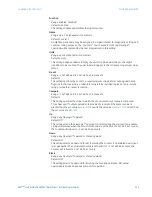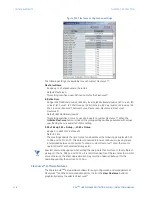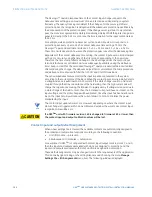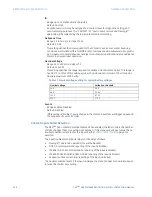
CHAPTER 7: PROTECTION
PROTECTION INPUTS AND OUTPUTS
D90
PLUS
LINE DISTANCE PROTECTION SYSTEM – INSTRUCTION MANUAL
385
Name
Range: up to 12 alphanumeric characters
This value displays the programmed
ID
for the corresponding protection virtual output.
Status
Range: On, Off
This value indicates the logic state of the protection virtual output.
Contact input configuration
The D90
Plus
can monitor the status of up to 115 field contacts. Each input can be wetted
from the D90
Plus
48 volt auxiliary supply or from an external power supply. Each contact
input has a dedicated delay timer for filtering of contact bouncing. The D90
Plus
can also
detect an oscillating input via the chatter feature. Each contact input active impedance
circuitry to provide security against false turn-on of an input due to excessive stray
capacitance of field wiring.
A raw status is scanned synchronously for all contact inputs at the rate of 0.25 ms as
shown below. A new contact input state must be maintained for a user-programmable
debounce time for the D90
Plus
to validate the new contact state. The debounce time is set
at 2.0 ms in the figure below; as such, the eighth sample validates the change of state
(mark 1 in the figure below). Once validated (de-bounced), the contact input asserts a
corresponding FlexLogic™ operand and logs an event (if event logging is enabled).
A time stamp of the first sample in the sequence that validates the new state is used when
logging the change of the contact input into the event recorder (mark 2 in the figure
below).
Figure 325: Contact input debouncing mechanism and time-stamping
Protection elements, as well as FlexLogic™ equations and timers, are executed sixteen
times in a power system cycle. The protection pass duration is controlled by the frequency
tracking mechanism. The FlexLogic™ operand reflecting the debounced state of the
contact is updated at the protection pass following the validation (mark 3 in the figure
above). The update is performed at the beginning of the protection pass so all protection
functions and protection FlexLogic™ equations, are fed with the updated states of the
contact inputs.
$&'5
9DOLGDWLRQWKUHVKROG
GHERXQFH
GHERXQFH
3URWHFWLRQ
SDVV
VFDQ
WLPH
7LPHVWDPS
DSSOLHG
7LPHVWDPS
DSSOLHG
2))
21
/2:
+,*+
,QSXW
YROWDJH
5DZ
FRQWDFW
VWDWH
)OH[/RJLF
RSHUDQG
$FWLYH
LPSHGDQFH
3URWHFWLRQ
SDVV








































